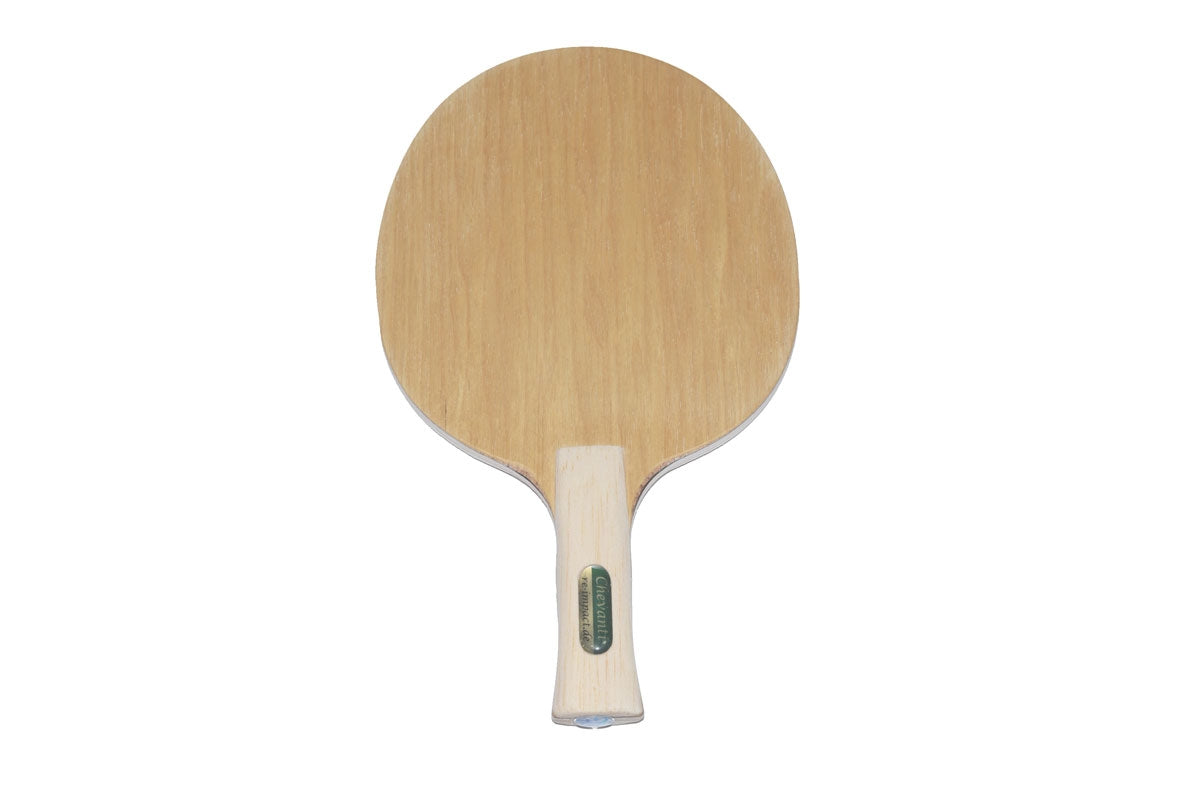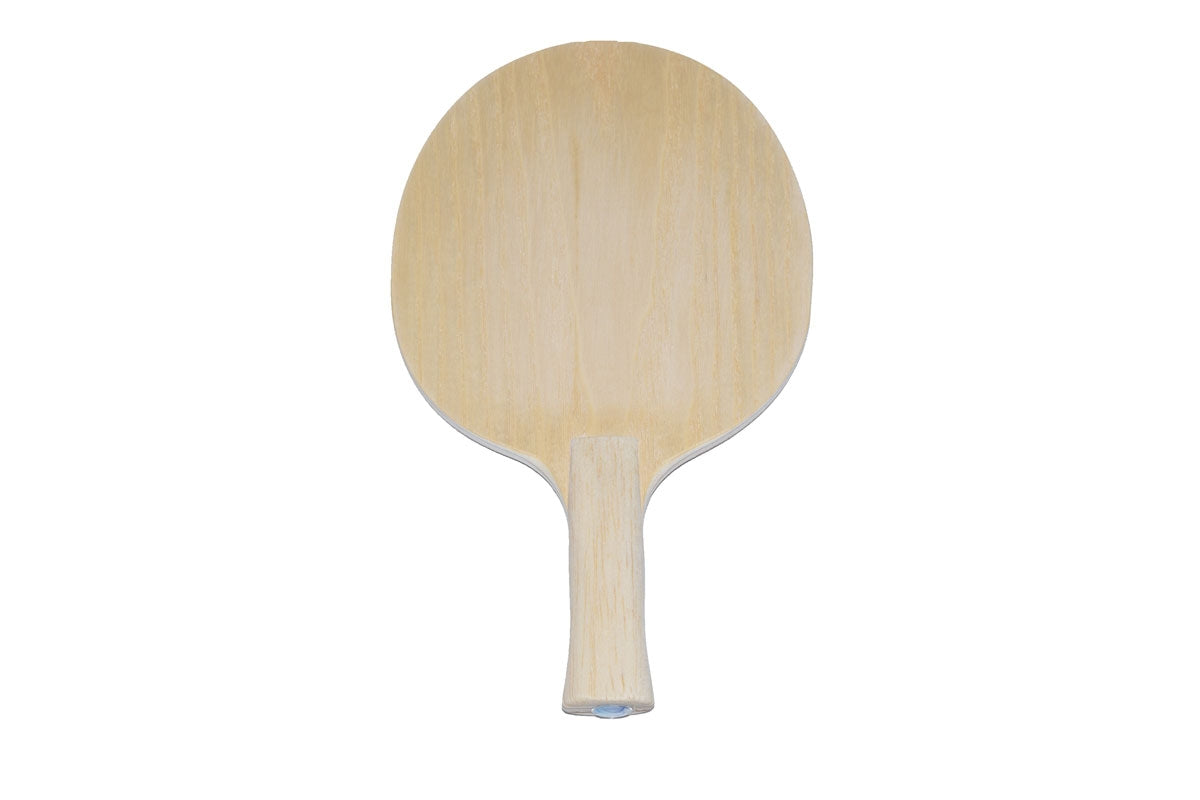

The Re-Impact Chevalier Table Tennis Blade
The concept that was already applied in the production of the forehand of the Re-Impact Chevalier and the backhand with smooth anti has also been implemented in the design of the Re-Impact Chevanti.
Compared to the Re-Impact ChevantiS, the only difference is in the forehand, which is designed classically linear in the Re-Impact Chevanti. The Re-Impact Chevanti thus achieves sufficient mass effect to be able to control aggressive, fast balls from the opponent at any time.
The new competition blade is now built in nine layers, so no elaborate prototype selection is necessary for this competition blade. Since the plastic ball has the negative property of becoming statically charged when there is a lot of heat in play, it attracts particularly high-friction playing surfaces during longer rallies, which can noticeably reduce the spin of the ball. However, this static charge does not occur with smooth anti rubbers.
The theory of initially unstable ball control due to high angle sensitivity could also support, generate, or reverse a greater disruptive effect of the ball. On the one hand, the ball can be carried along longer and stronger, depending on the resistance of the rubber, and on the other hand, higher passive safety of the angled shot can be guaranteed, as the blade could logically guide the ball even longer than would normally be the case.
The asymmetrical blade grip guarantees extremely flat and precise ball trajectories in all conceivable playing situations, which are reproducible and also pursue the development goal of protecting arm and shoulder joints, as only minimal air resistance is created during the forward movement of the ball. With the additional order of the Mcp system, you can even optimize the individual ball flight length based on each player's individual body measurements, so that the played balls will all land about 25-35 cm and with smooth anti even up to 40 cm before the baseline, if a good balance hand is supported and played by the player themselves.
The total weight is chosen to noticeably relieve the arm and shoulder joints, and at the same time ensures a very good mass effect through the playing surfaces used. When surprised by fast topspin or hit spins from the opponent, the balls will not suddenly rise even with technically less skilled players thanks to the well-balanced blade, but will always remain nicely flat.
The application field of the Chevanti must be viewed more universally. It is not only suitable for all fast smooth anti rubbers, but is also excellent for controlling semi-tacky, fast anti rubbers. The Chevanti is also suitable for players who want an extremely safe backhand with a perfect alignment of the forehand under normal rubbers; but also want to play it more directly and very shot-safe.
Thus, the entire development potential of a perfect line and application with Re-Impact Chevalier, Hyperion, "Chevanti" and "ChevantiS(oft)" is available for all table tennis players. The color of the rubbers no longer plays a role with the Chevanti. It can also wonderfully dampen or passively slow down very fast long pimpled rubbers.
| Weight | |
|---|---|
| Thickness The thickness of the blade in millimeters. | |
| Control Indicates how well the ball can be controlled with the blade. | |
| Effet Indicates how well spin can be generated with the blade. | |
| Bending Elasticity Indicates how flexible or stiff the blade is on ball contact. | |
| Application Area Indicates which playing style (offensive, defensive, all-round) the blade is best suited for. | |
| Technique Indicates whether the blade is more suitable for passive or active players. | |
| Composite Wood A blade where the two sides are made of different veneers. |
Custom Fitting for Your Perfect Grip
We offer the option to have your grip individually customized to your hand size. This ensures optimal comfort and perfect handling.
Grip Types and Customization Options
-
•
Standard Grips
Anatomic, Straight, Concave
Customization of length and circumference (thickness) is possible.
-
•
Special Shapes
Conical Grip, Beaver Grip, Propeller Grip, Special Grip
Customization to your hand size is possible.
How It Works
First, select your desired blade size.
After selecting the blade size, the grip selection option will appear.
Below the grip selection, you will find a text field labeled "Your Hand Measurements". Please enter your measurements there.
If you do not provide any measurements, we will produce the grip in the respective standard size.
Measurement Guide
To customize your grip perfectly, we need the following information from you:
-
•
Lines 1-6 (L1 - L6)
Measure the lengths of lines 1 to 6, as shown in the diagram.
-
•
Forearm Length (U)
Measure the length of your forearm (inner side) from the elbow joint to the wrist.
Unit of Measurement: cm
Copy Template:
Important Note:
These measurements are required for all grip types (including Propeller, Conical, and Beaver grips).
Blade Sizes: Small, Medium, and Large
Here you'll find a detailed overview of our different blade sizes - Small, Medium, and Large - to help you choose the optimal blade for your game.
Small
Width: 157 mm
Height (Blade): 152 mm
Height (Total): 253 mm
All-round players who value control and a balanced feel. Serves as a reference for speed/weight.
Medium
Width: 162 mm
Height (Blade): 162 mm
Height (Total): 264 mm
prefer a larger hitting area and want to benefit from a bit more forgiveness.
Large
Width: 162 mm
Height (Blade): 168 mm
Height (Total): 270 mm
a defensive player or beginner, if you focus on maximum consistency and a maximum hitting area.
Important Notes on Speed, Weight, and Playing Characteristics
-
Reference Values (Small)
All information on speed and weight in our product descriptions always refers to the small blade. This serves as a reference point for the other sizes.
-
Speed
The larger blades (Medium and Large) have a lower speed compared to the small blade. The differences are measurable and can be noticeable, depending on the player type.
-
Weight
The weight difference between the three sizes can be up to 20 grams. This difference is noticeable and influences the swing characteristics, balance, and overall handling of the blade.
-
Hitting Area
The main advantage of the medium and large blades is the enlarged hitting area. This leads to greater forgiveness and a more secure ball feel, especially on off-center hits.
-
Sweetspot
A larger blade can also have a slightly larger sweetspot (the optimal point of contact), which can further improve control and precision.
In Summary - Which Blade is Right for You?
- Small: Balanced feel, control, reference size.
- Medium: Larger hitting area, more forgiveness, slightly less speed, significant weight difference.
- Large: Maximum hitting area, highest consistency, lower speed, significant weight difference, ideal for defensive players and beginners.
Our Recommendation: Choose the blade size that best suits your individual playing style, experience, and personal preferences. Take into account the described differences in size, speed, weight, and hitting area.
Handle Shapes
Anatomical
The anatomical handle fills the palm well. It sits very firmly in the hand.Concave
Straight
Penholder/pen-hold
The penholder grip allows only one side of the racket to be used, it's optimal for wrist variations.
Japanese penholder style – racket with a long, angular handle (Penholder Jap.)
Chinese penholder style – racket with a short, flat handle (Penholder Chin.)
Conical handle(FL)
The conical handle is a round tapered handle that can be easily rotated while still sitting securely in the hand.Beaver handle
The beaver handle has a wide, one-sided flat-running end, making it secure and comfortable in the hand.
Ship's propeller
a handle rotated by 45 degrees, which sits well in the hand
Ergonomic

The ergonomic pistol grip is a replica of James Haylord's invention created for our products. The original grip is designed so that the hand, including all fingers, rests on the handle and not on the blade. However, with our product, the thumb and index finger rest on the respective hitting surface, so the handle shaft has been optimally redesigned. The advantage is that the grip now allows for better hand guidance to the racket wood. However, the grip is purely handmade and not easy to produce.
Noble sealing Mahogany

The noble sealing in mahogany looks wonderful because the noble stain completely colors the wood structure and further solidifies the surface of the balsa. This way, you don't see any signs of use as with lighter woods, and due to the surface hardening, the playing characteristics such as ball control are perceived even more clearly, without the wood's natural vibration being transmitted to the hand. In addition, the wood is better protected against humidity and sweat.
The MCP system is a special grip system that
1. controls the mass effect of the racket by allowing you to reduce the pressure point of the racket for passive shots and, conversely, immensely increase it for active shots. This requires an elaborate grip shell, consisting of a surface layer of hardwood and an underlayer of softwood, because the direct underlayer must be able to vibrate elastically, similar to a tuning fork. This way, I can
2. systematically extend the KSLS system notches in the handle to allow the upper blade to vibrate more elastically and generate even more spin, but also
3. obtain a more appealing surface grip that doesn't absorb hand sweat as quickly.









